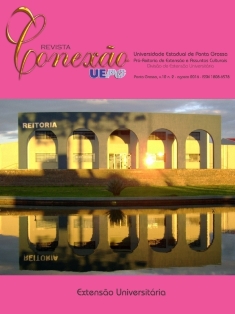A IMPORTÂNCIA DA COMUNICAÇÃO: FAMILIARES DE PACIENTES INTERNADOS EM UM CENTRO DE TERAPIA INTENSIVA – DOI: 10.5212/Rev.Conexao.v.12.i2.0002
DOI:
https://doi.org/10.5212/Rev.Conexao.v.12.i2.0002Parole chiave:
Comunicação, Enfermagem, Família, Terapia Intensiva.Abstract
Este artigo teve origem no projeto de extensão “O cotidiano de familiares de pacientes internados no Centro de Terapia Intensiva (CTI)”, tendo como objetivos avaliar o grau de satisfação dos familiares de pacientes internados no CTI para com a assistência recebida; informar os principais momentos que a equipe de saúde instituiu a comunicação com os familiares dos pacientes internados no CTI e verificar se os familiares confiam nas informações recebidas. Trata-se de um estudo qualitativo, descritivo, realizado no CTI do Hospital Universitário João de Barros Barreto, em Belém do Pará, de maio a julho de 2015, com 40 familiares, através de entrevista semiestruturada e analisada pela técnica de análise de conteúdo. Os resultados apontam três categorias: O primeiro contato com o CTI: a importância da comunicação; Quando a equipe de saúde fala comigo e Comunicação versus confiança. Esse estudo demonstrou que a comunicação em saúde, quando utilizada adequadamente, torna-se uma excelente ferramenta no cuidado em saúde.Downloads
Riferimenti bibliografici
AGUIAR, A. S. C; et al. Percepção do enfermeiro sobre promoção da saúde na Unidade de Terapia Intensiva. Revista da Escola de Enfermagem USP, São Paulo, v. 46, n. 2, p. 428-35. 2012.
ALVES, E. F. O Cuidador de Enfermagem e o Cuidar em Uma Unidade de Terapia Intensiva. UNOPAR Científica Ciências Biológicas e da Saúde, v. 15, n. 2, p.115-22. 2013
ANDRADE, M. A; et al. Comunicação no contexto hospitalar como estratégia para a segurança do paciente: Revisão integrativa. Revista Rede de Cuidados em Saúde, v. 7, n. 1. 2013.
BARDIN, L. Análise de conteúdo. Edições 70, LDA, Lisboa, Portugal. 2009.
BEUTER, M; et al. Sentimentos de familiares acompanhantes de adultos face ao processo de hospitalização. Escola Anna Nery (impr.), v. 16, n. 1, p. 134-140. Jan-mar. 2012.
BRASIL. Resolução nº 466. Dispõe sobre pesquisa com seres humanos. Publicada no DOU nº 12. Seção 1, p. 59. 13 jun 2013. Disponível em: <http://conselho.saude.gov.br/resolucoes/2012/Reso466.pdf>. Acesso em: 04 de Nov. 2015.
CASARINI, K. A; et al. Análise qualitativa do uso de manual informativo para familiares em UTI. SPAGESP - Sociedade de Psicoterapias Analíticas Grupais do Estado de São Paulo. Revista da SPAGESP, v. 14, n. 2, p. 55-72. 2013.
CRUZ, D. S. M; PEDRO, S. L. B; FASSARELA, C. S. A comunica ação entre equipe de enfermagem e acompanhante visando à segurança do paciente oncológico durante o processo de hospitalização. Revista Rede de Cuidados em Saúde. v. 7, n. 1. 2013.
DAHDAH, D. F. et al Grupo de familiares acompanhantes de pacientes hospitalizados: estratégia de intervenção da Terapia Ocupacional em um hospital geral. Caderno de Terapia Ocupacional UFSCar, São Carlos, v. 21, n. 2, p. 399-404, 2013.
HADDAD, J. G. V; et al. A comunicação terapêutica na relação enfermeiro-usuário da atenção básica: um instrumento para a promoção da saúde e cidadania. O Mundo da Saúde, São Paulo, v. 35, n. 2, p. 145-155. 2011.
FREITAS, K. S; MUSSI, F. C; MENEZES, I. G. Desconfortos Vividos no Cotidiano de Familiares de Pessoas Internadas na UTI. Escola Anna Nery (impr), v. 16, n. 4, p. 704-11. Out-dez. 2012.
GIRARDON-PERLINI, N. M. O; et al. Percepções e sentimentos da família na interação com a equipe de enfermagem na UTI neonatal. Ciência Cuidado e Saúde, v. 11, n. 1, p. 26-34. Jan-Mar. 2012.
OLIVEIRA, C. N; NUNES, E. D. C. A. Cuidando da família na UTI: desafio de enfermeiros na práxis interpessoal do acolhimento. Texto Contexto Enfermagem, Florianópolis, v. 23, n. 4, p. 954-63. Out-Dez. 2014.
OLIVEIRA, L. A, et al. Discursos em saúde. A comunicação a serviço de quem? In: 4º Congresso Ibero-Americano em Investigação Qualitativa. E 6º Simpósio Internacional de Educação e Comunicação. Atas CIAIQ2015, v. 1, 2015, p. 452-4.
OLIVEIRA, N.E.S. Humanização do cuidado em terapia intensiva: saberes e fazeres expressos por enfermeiros. Dissertação (Mestrado). Universidade Federal de Goiás, Faculdade de Enfermagem - Programa de Pós-Graduação em Enfermagem. 2012. Disponível em:<http://mestrado.fen.ufg.br/uploads/127/original_Nara_Elizia_Souza_de_Oliveira.pdf?1391017634>. Acesso em: 08 de Out. 2015.
PUGGINA, A. C; et al. Percepção da comunicação, satisfação e necessidades dos familiares em Unidade de Terapia Intensiva. Escola Anna Nery, v. 18, n. 2, p. 277-83. Abr-Jun. 2014.
RAMOS, M. N. P. Comunicação em Saúde e Interculturalidade – Perspectivas Teóricas, Metodológicas e Práticas. Ensaio. RECIIS – Revista Eletrônica de Comunicação, Informação e Inovação em Saúde, v. 6, n. 4, p. 1-19. Dez. 2012.
RODRIGUES, M. V. C; FERREIRA, E. D; MENEZES, T. M. O. Comunicação da enfermeira com pacientes portadores de câncer fora de possibilidade de cura. Revista de enfermagem UERJ. Rio de Janeiro, v. 18, n. 1, p. 86-91. 2010.
SIMONI, R. C. M; SILVA, M. J. P. O impacto da visita de enfermagem sobre as necessidades dos familiares de pacientes de UTI. Revista da Escola de Enfermagem USP, v. 46 (Especial), p. 65-70. 2012.
ZANI, A. V; et al. As interfaces da convivência da família em uma unidade de pronto socorro. Ciência Cuidado e Saúde, v. 10, n. 4, p. 803-11. 2011.
Downloads
Pubblicato
Fascicolo
Sezione
Licenza
a) Os autores mantêm os direitos autorais e concedem à revista o direito de primeira publicação, com o trabalho simultaneamente licenciado sob a Creative Commons Attribution License que permite o compartilhamento do trabalho com reconhecimento da sua autoria e publicação inicial nesta revista.
b) Ao submeter um artigo à Revista Conexão UEPG e tê-lo aprovado os autores concordam em ceder, sem remuneração, os seguintes direitos à Revista: os direitos de primeira publicação e a permissão para que a Revista redistribua esse artigo e seus metadados aos serviços de indexação e referência que seus editores julguem apropriados.
c) Os leitores são livres para transferir, imprimir e utilizar os artigos publicados na Revista, desde que haja sempre menção explícita ao(s) autor (es) e à Revista Conexão UEPG e que não haja qualquer alteração no trabalho original. Qualquer outro uso dos textos precisa ser aprovado pelo(s) autor (es) e pela Revista.

Este obra está licenciado com uma Licença Creative Commons Atribuição 4.0 Internacional.





